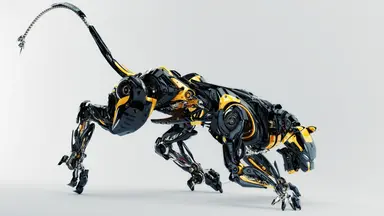China’s Bionic Robot Mimics Cheetah’s Speed and Agility with Cutting-Edge Material Technology
China has taken a giant leap in robotics with the introduction of a bionic robot that moves with the speed and agility of a cheetah. This futuristic creation, developed by leading engineers and scientists, utilizes groundbreaking material technology and artificial intelligence to replicate the powerful and fluid motion of the world’s fastest land animal.
A Leap in Robotic Mobility
Unlike conventional robots that rely on rigid mechanical joints and motors, this bionic cheetah incorporates an innovative flexible material that closely mimics the elasticity and responsiveness of animal muscles. By doing so, the robot can sprint, turn, and even leap with remarkable grace, making it one of the most advanced robotic mobility systems ever developed.
The key breakthrough lies in the integration of smart materials, which allow the robot’s limbs to contract and expand dynamically, just like the tendons and muscles of a real cheetah. Researchers explain that this advancement significantly reduces mechanical stress and energy consumption, enabling the robot to operate with higher efficiency and speed.
Inspired by Nature, Powered by AI
To achieve lifelike motion, the bionic cheetah is equipped with cutting-edge AI algorithms that analyze its surroundings in real time. Using high-speed cameras and advanced sensors, the robot can adapt to different terrains, maintain stability at high speeds, and make split-second decisions—just as a real predator would in the wild.
Scientists have meticulously studied the biomechanics of cheetahs, particularly how they use their flexible spine and powerful limbs to propel themselves forward. By applying this understanding to robotic engineering, they have created a machine that can accelerate quickly, maintain balance even on uneven ground, and execute swift directional changes with precision.
Revolutionizing Robotics with Multifunctional Applications
This robotic innovation has the potential to revolutionize multiple industries. In disaster response scenarios, the bionic cheetah could navigate through rubble and debris at high speeds to locate survivors. In military and surveillance operations, it could serve as an ultra-fast reconnaissance unit capable of covering large areas in a short time.
Moreover, the technology behind this robot could lead to improvements in prosthetics and wearable exoskeletons, enhancing mobility for individuals with disabilities. The same principles of flexible, muscle-like materials could be applied to medical robotics, creating more adaptive and responsive artificial limbs.
The Future of Bio-Inspired Robotics
China’s latest innovation represents a new frontier in the field of bio-inspired robotics. As researchers continue to refine the technology, we could soon see even more advanced robots that blend the agility of nature with the intelligence of AI.
With this bionic cheetah, China has set a new standard in robotic mobility, proving that the future of robotics may lie not in stiff metallic machines, but in flexible, muscle-like structures that move with the elegance and speed of the natural world.





